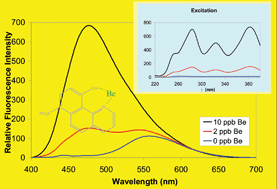Analytical methods for the determination of trace beryllium in soils are needed so that anthropogenic sources of this element can be distinguished from native (background) levels of beryllium. In this work, a collaborative interlaboratory evaluation of a new extraction and fluorescence-based procedure for determining beryllium in soil samples was carried out to fulfil method validation requirements for ASTM International voluntary consensus standard test methods. A Canadian reference material, CCRMP Till-1 soil, with a background beryllium concentration of 2.4 μg g−1, was selected for study. This certified reference material (CRM) was spiked and homogenized with varying levels of beryllium oxide in order to give batches of material with beryllium concentrations of 4.36 ± 0.69, 11.5 ± 0.7, 124 ± 7 and 246 ± 16 μg g−1 (± values are standard deviations). In the interlaboratory study (ILS), which was carried out in accordance with an applicable ASTM International standard practice (ASTM E691), samples of these spiked soils were subjected to extraction in dilute ammonium bifluoride at ∼90 °C for 40 h. Fluorescence measurement of the extracted beryllium was carried out via detection using the high quantum yield fluorophore, hydroxybenzoquinoline sulfonate (HBQS). Interlaboratory precision estimates from six participating laboratories ranged from 0.048 to 0.103 (relative standard deviations) for the five different beryllium concentrations. Pooled bias estimates resulting from this ILS were between −0.049 and 0.177 for the various beryllium levels. These figures of merit support promulgation of the analytical procedure as an ASTM International standard test method.

You have access to this article
 Please wait while we load your content...
Something went wrong. Try again?
Please wait while we load your content...
Something went wrong. Try again?


 Please wait while we load your content...
Please wait while we load your content...